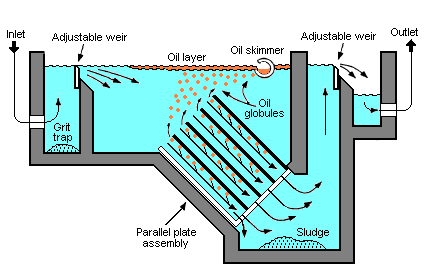API oil separator
An API oil separator is a device designed to separate large amounts of oil and dissolved solids from wastewater from oil refineries, (petro) chemical and other industrial plants.
The name API refers to the standard of the American Petroleum Institute according to which such devices are designed.
Description of how it works
The API oil separator uses Stokes' equation to separate using gravity. The difference in relative density between oil and wastewater is important for how it works.
Usually the oil layer is skimmed off.
Parallel plate separators are similar to API separators, but include slanted plate components.
history
The API oil separator was developed by the API and the Rex Chain Belt Company (now USFilter Envirex Products ). The first API oil separator was installed in the Atlantic Richfield Company refinery in Philadelphia in 1933 . Since then, almost all refineries around the world have installed API oil separators in their wastewater treatment plants. However, many refineries today use plastic parallel plate packing to increase gravity separation.
See also
Individual evidence
- ↑ a b American Petroleum Institute (API) : Management of Water Discharges: Design and Operations of Oil-Water Separators , 1st Edition. American Petroleum Institute, February 1990.
- ↑ a b c Beychok, Milton R .: Aqueous Wastes from Petroleum and Petrochemical Plants , 1st Edition. Edition, John Wiley & Sons, 1967, LCCN 67019834.

